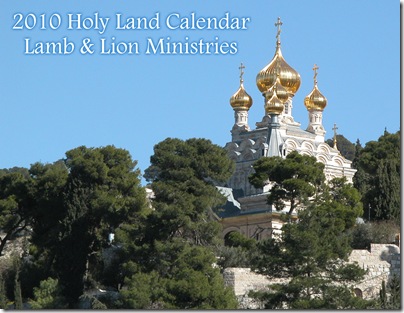You know that the year is drawing to a close when you see calendars for 2010 on store racks. I just received yesterday the 2010 Holy Land Calendar produced by Lamb and Lion Ministries, which exclusively features photographs from BiblePlaces.com. The calendar notes all the major American holidays, and its inclusion of the Jewish holy days makes it a great way to keep track of important events not on many American calendars. You can purchase this beautiful calendar online, and if you order 10 (for Christmas gifts), they will give you two for free.
From a press release from the University of Haifa:
The remains of a Minoan-style wall painting, characterized by a blue background, the first of its kind to be found in Israel, was discovered in the course of the recent excavation season at Tel Kabri. This fresco joins others of Aegean style that have been uncovered during earlier seasons at the Canaanite palace in Kabri. “It was, without doubt, a conscious decision made by the city’s rulers who wished to associate with Mediterranean culture and not adopt Syrian and Mesopotamian styles of art like other cities in Canaan did. The Canaanites were living in the Levant and wanted to feel European,” explains Dr. Assaf Yasur-Landau of the University of Haifa, who directed the excavations.
The remains of a Canaanite city from the Middle Bronze Age (2000-1550 B.C.) have been exposed at Tel Kabri, next to Kibbutz Kabri near Nahariya. A palace for the city’s rulers stands in the center of the city, which was the most important of the cities in the Western Galilee during that period. Excavations began at Tel Kabri in 1986, conducted by the late Prof. Aharon Kempinski, and were halted in 1993. Over the past years, excavations have been renewed by teams directed by Dr. Yasur-Landau of the Leon Recanati Institute for Maritime Studies at the University of Haifa and Prof. Eric Cline of The George Washington University. Tel Kabri is unique in that after the city was deserted, no other city was built over its remains. Therefore, this is the only Canaanite city that can be excavated in its entirety. The palace too, which has been measured with geophysical tools at 1 to 1.5 acres, is the only such palace of this period that can be excavated fully. “The city’s preservation enables us to get a complete picture of political and social life in the Canaanite period. We can reveal whether or not it had a central government, whether taxes were levied, what sort of agriculture there was and how politics were conducted at the time,” Dr. Yasur-Landau explains.
The full press release is here, and an Arutz-7 story is here. If you’ve been to Crete, you may be a bit disappointed with the photos.
HT: Joe Lauer
Tell Kabri, Middle Bronze palace, October 2005
- Tagged Discoveries, Excavations
Search
About the BiblePlaces Blog
The BiblePlaces Blog provides updates and analysis of the latest in biblical archaeology, history, and geography. Unless otherwise noted, the posts are written by Todd Bolen, PhD, Professor of Biblical Studies at The Master’s University.
Subscribe
Tags
10th Century
American Colony Photos
Analysis
Antiquities Trade
Dead Sea
Dead Sea Scrolls
Discoveries
Egypt
Excavations
Forgery
Galilee
Greece
Holidays
Israel's Coast
Italy
Jerusalem
Jezreel Valley
Jordan
Jordan Rift
Judah
Lebanon
Lectures
Mediterranean Islands
Mesopotamia
Museums
Negev
New Exhibits
Persia
Philistines
Photo Resources
Picture of the Week
Pseudo-Archaeology
Resources
Sad News
Samaria
Shephelah
Syria
Technology
Temple Mount
Tomb of Jesus
Tourism
Travels
Turkey
Weather
Weekend Roundup
Links
Notice
As an Amazon Associate we earn from qualifying purchases. In any case, we will provide honest advice.

